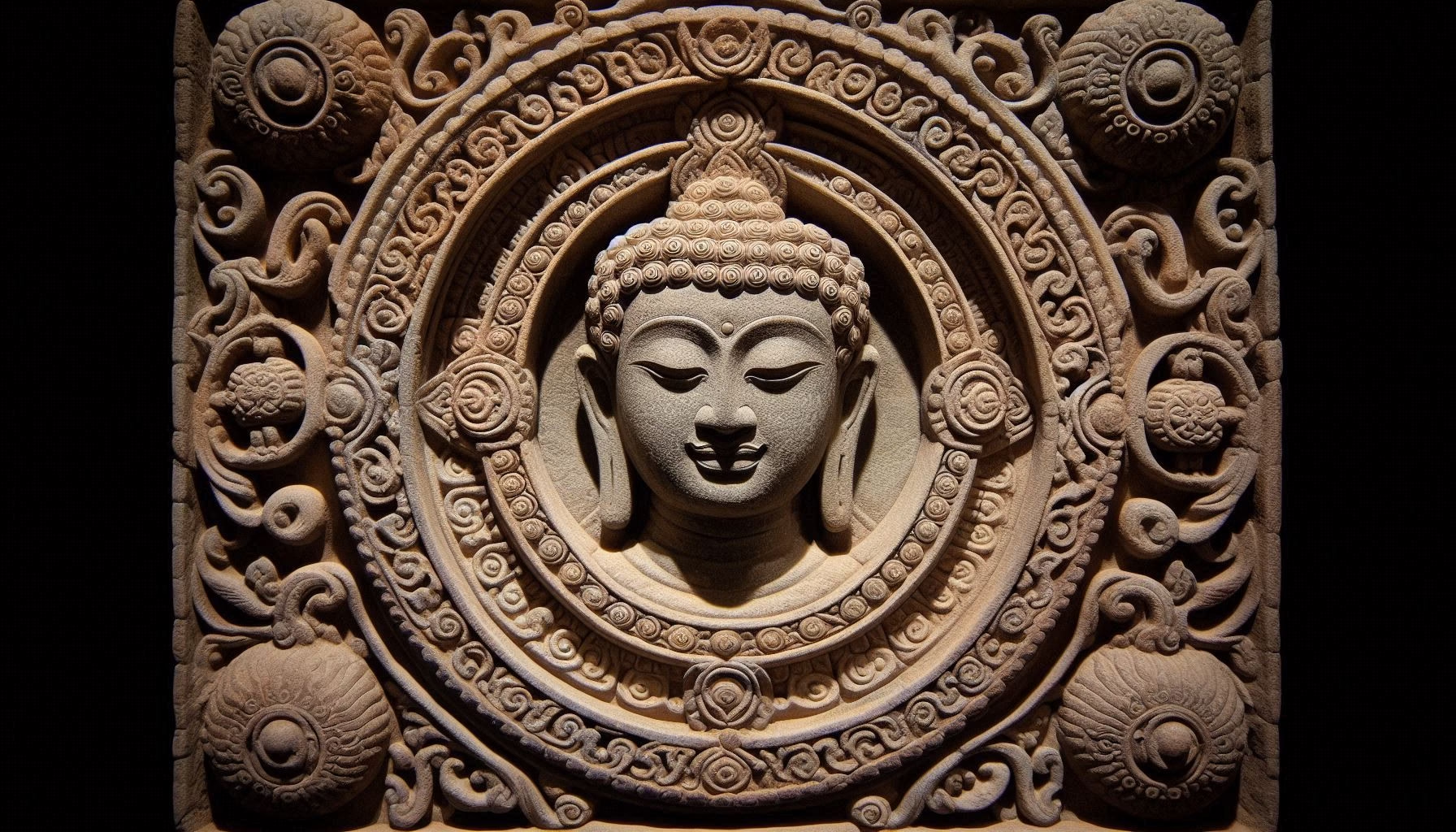
Enter an eternal exploration of Buddhist art which fuses spiritual essence with skilled craftsmanship to produce serene masterpieces full of wisdom.
The physical materials of stone, paint, and metal become symbols of enlightenment through a deep combination of spiritual essence and artistic technique in Buddhist art. From the tranquil Buddha statues of Thailand to the intricate mandalas of Tibet, this art form captures the essence of Buddhism’s teachings: Buddhist teachings distill into three core principles which are compassion towards all beings, practicing mindfulness in everyday life and pursuing inner peace within oneself. This blog explores the depths of Buddhist art by examining its historical beginnings and its enduring artistic and spiritual value.
The Roots of Buddhist Art
The emergence of Buddhist art in India around the 3rd century BCE was initiated by Emperor Ashoka’s dedication to Buddhist teachings. Early Buddhist art practiced aniconism by representing the Buddha through symbols such as the Dharma wheel and Bodhi tree. His followers believed that his teachings existed beyond any physical representation.
When Buddhism extended into regions like China, Japan, Sri Lanka, and other areas art specialists combined native methods with Buddhist iconography. For instance:
- The artistic style of Gandhara (1st–5th century CE) blended Greco-Roman realism with Indian motifs to create realistic depictions of the Buddha.
- The art of the Khmer people created the delicate sculptures found at Cambodia’s Angkor Wat site.
- The vibrant deity paintings in Tibetan thangkas served as tools for meditation practice.
Keyword tip: Use keywords like “origins of Buddhist art” or “Buddhist art history” to discover how Buddhist art has developed worldwide.
The Craftsmanship Behind Buddhist Art
The creation of Buddhist art demanded great expertise and religious dedication. Artisans who produced Buddhist art were frequently monks or dedicated laypersons who brought spiritual purpose to their creations. Key techniques included:
- Stone Carving: The Ajanta caves of India and Sri Lanka’s Gal Vihara contain serene Buddha rock sculptures produced by skilled sculptors.
- Bronze Casting: The process of bronze casting was employed in China and Japan to create precise Buddhist statues including the famous Great Buddha of Kamakura.
- Painting and Thangkas: Tibetan artists created complex scrolls through the application of mineral pigments designed for meditation.
- Woodwork: The temples of Southeast Asia were adorned with decorative wooden panels that show scenes from the Jataka tales.
The artist engaged in each brushstroke and chisel mark as a meditative practice which bridged their creative work with spiritual enlightenment.
Pro tip: Explore “Buddhist art techniques” to discover traditional methods that remain in practice today.
Spiritual Symbols in Buddhist Art
Through its visual language Buddhist art contains rich symbolic elements which direct the soul on its spiritual journey. Here are a few and their meanings:
- Buddha’s Mudras: Different hand gestures such as the Dhyana mudra for meditation and the Abhaya mudra for protection express Buddhist teachings.
- Lotus Flower: The lotus flower represents purity while rising above earthly ties.
- Mandala: Tibetan Buddhist meditation practices incorporate circular designs which symbolize the universe.
- Stupa: Dome-shaped structures at Sarnath and Borobudur represent the enlightened mind of the Buddha.
These symbols serve as prompts for contemplation about life’s fleeting nature and interconnected relationships.
Travel tip: Make sacred pilgrimages to Bodh Gaya and Lumbini to witness these symbols firsthand.
Iconic Buddhist Artworks to Know
Buddhist art has created a permanent imprint on global culture. Here are some masterpieces:
- Borobudur (Indonesia, 9th century CE): Borobudur serves as a pilgrimage destination for millions because it features thousands of reliefs and Buddha statues within its massive temple structure.
- Yungang Grottoes (China, 5th–6th century CE): The Yungang Grottoes feature massive cave art that merges Chinese and Central Asian artistic traditions.
- Sigiriya Frescoes (Sri Lanka, 5th century CE): The Sigiriya Frescoes show fine depictions of heavenly beings which reflect Buddhist inspiration.
- Horyu-ji Temple (Japan, 7th century CE): The Horyu-ji Temple holds some of the earliest known wooden Buddhist sculptures.
SEO tip: Explore virtual tours of famous Buddhist artworks through online search.
Why Buddhist Art Resonates Today
Buddhist art functions as a source of tranquility and mental clarity in our tumultuous world. The peaceful visual elements of Buddhist art promote mindfulness while demonstrating the pinnacle of human artistic achievement through its masterful construction. Contemporary artists incorporate these themes while wellness practitioners use mandalas as meditation tools. Exploring Buddhist art through visits to Kyoto temples or home sketches of lotus flowers links you to 2,500 years of aesthetic and philosophical tradition.
How to Experience Buddhist Art
Ready to explore? Try these:
- Museums: Explore Buddhist art collections at the Guimet Museum in Paris or the Tokyo National Museum.
- Books: For an in-depth study explore Buddhist Art and Architecture written by Robert E. Fisher.
- Destinations: Witness living art traditions by touring Bagan in Myanmar or Wat Pho in Thailand.
- Online: Google Arts & Culture lets you take virtual tours of temples online.
Keyword suggestion: Look up “Buddhist art inspiration” and “Buddhist temple art” to discover additional resources.
Final Thoughts
Buddhist art represents a spiritual voyage where artistic techniques transform ordinary materials into paths leading to enlightenment. The symbols and stories found in Buddhist art guide us to find inner peace and engage in intentional creation. Both art lovers and spiritual explorers should find inspiration for their personal journeys through this enduring tradition.
Which Buddhist artwork speaks to you? Leave your thoughts below and subscribe for additional content about art, culture and spirituality.